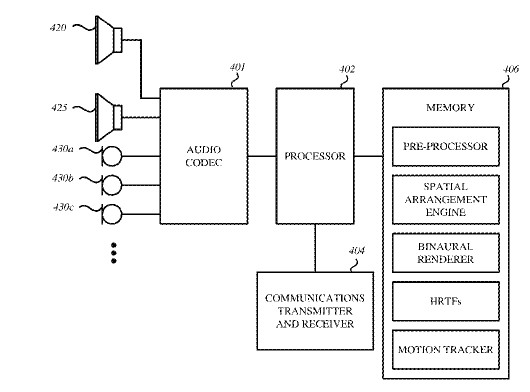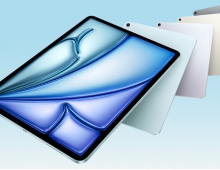
Apple Patent Describes AR Headphones
Apple has been granted a patent for AR headphones, which enable you to hear where people are located within a room even when they are not physically present.
The patent, filed with the USPTO in June 13, 2017 is entitled an "Intelligent augmented audio conference calling using headphones." Here is the abstract:
In one aspect herein, a pre-processor receives audio signals for a conference call from individual callers, each of the audio signals associated with corresponding metadata, analyzes the metadata, and associates each of the audio signals with a spatial position in a virtual representation of the conference call based on the analysis of the metadata. A spatial arrangement processor generates a binaural room impulse response associated with the spatial position of each of the audio signals to filter the received audio signals to account for the spatial position associated with each of the audio signals and to account for the effect of the virtual representation of the conference call. A head-tracking controller tracks an orientation of a listener's head using a headset. A binaural renderer produces multi-channel audio data for playback on the headset according to the orientation of the listener's head and the binaural room impulse response associated with the spatial position of each of the audio signals

The patent uses augmented reality headphones in a conference room, designed to allow the wearers of the headphones listen to conference calls, but it’s not hard to also imagine some entertainment-based uses.
The headphones would provide augmented stereo sound designed to help you hear where in a real or virtual meeting room each person is sitting, so that you can tell who is speaking without having to rely solely on recognizing their voice.
Multiparty audio conference calls typically include audio signals from individual callers in different locations, such that it may be difficult to recognize who is speaking by voice alone. Often, a listener uses a stereo headset to listen to the conversation, and the audio signals may be processed to enhance recognition of the different participants […]
Audio signals from the individual callers are processed by simulating a virtual audio environment (e.g., virtual room) whose acoustic properties resemble those of the real environment in which the listener is situated. Metadata included in the audio signals may be used to automatically cluster callers and reposition groups of participants in the virtual audio environment. Using a head-tracked sound reproduction system, the audio signals are dynamically filtered with binaural room impulse responses to account for and preserve the rendered location of the callers in the virtual audio environment. To increase speech intelligibility, the listener can rotate to the position of the active speaker, similar to a natural conversation.
This means that if you turn your head to ‘face’ someone, the AR headphones would adjust the audio in the same way it would if you were actually present in a real meeting room. The virtual position of other people will also adjust, so you have the same impression of where they are sitting no matter which way you turn your head.
During a conference call in which all of the participants are in different locations, the system would create a virtual room, and assign a position to each person as they join. If there is a primary presenter or speaker, they can be positioned centrally.
As always, patents mostly describe products that may never make it to market. Apple is, however, believed to be working on some kind of AR headset dubbed Apple Glasses, expected to launch within the next years.





















